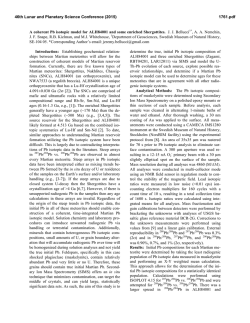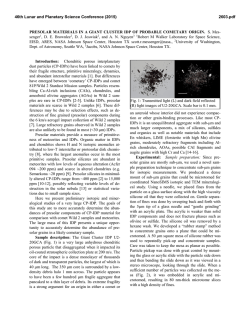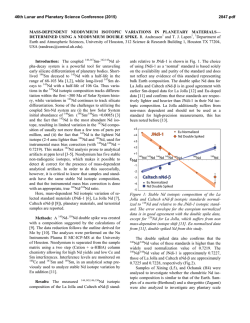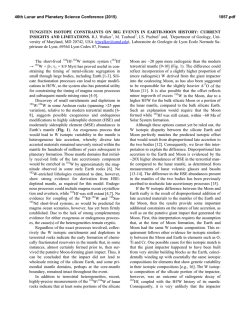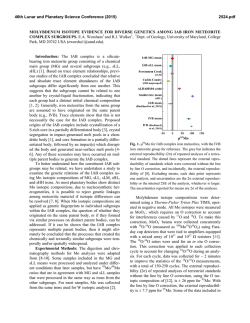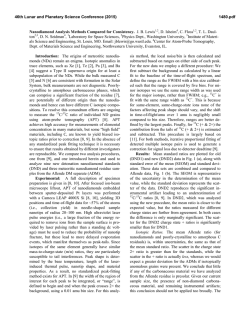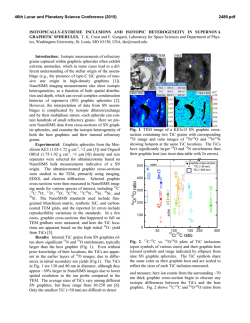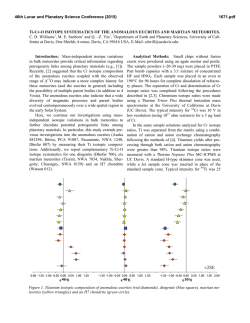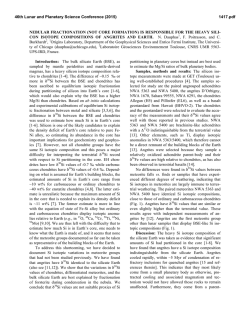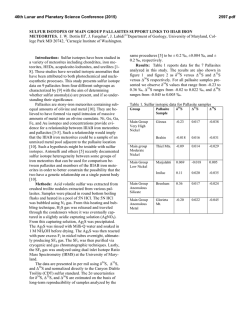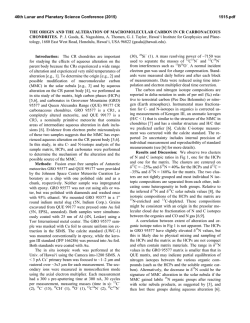
HIGH-PRECISION U-Pb AND Pb
46th Lunar and Planetary Science Conference (2015) 2340.pdf HIGH-PRECISION U-Pb AND Pb-Pb GEOCHRONOLOGY AT UC DAVIS – FIRST RESULTS FOR EARLYTIME STANDARDS. M.H. Huyskens, M.E. Sanborn and Q.-Z. Yin, Department of Earth and Planetary Sciences, University of California-Davis, One Shields Avenue, Davis, CA, USA, email: [email protected] Introduction: The U-Pb and Pb-Pb chronometers are one of the most valuable tools for precise dating of rocks and minerals from the beginning of the solar system to less than 1 Ma. In the last decade many improvements have been made to achieve a higher precision with this chronometer. For meteorites the precision is commonly a few 10s-100s ka. However, with increasing precision, differences in analytical protocols and data reduction procedure can potentially cause interlaboratory discrepancies. The EarlyTime Initiative provides standard materials with the aim to detect and eliminate any discrepancies and work as a community towards standardized protocols among all participating laboratories [1]. As a laboratory that is new to U-Pb geochronology (efforts are underway since October 2014), we report our analytical protocols and first results for the standards provided by the EarlyTime Initiative. Materials: The EarlyTime standards are a series of five solutions that have been prepared to form a linear array in 204Pb/206Pb-207Pb/206Pb space, approximating the age of the solar system as well as yielding concordant U-Pb dates [1]. This was achieved by preparing two endmember solutions, one mimicking the solar system initial Pb composition, the second having a highly radiogenic Pb isotopic composition and corresponding U concentration. The three intermediate solutions were prepared by mixing these two endmembers in different proportions [1]. Methods: Uranium isotopic composition of the EarlyTime standards were determined on a Neptune Plus MC-ICP-MS in the Yin Lab at the University of California, Davis. The original standards were diluted to 70-30 ppb in 2% HNO3 solution containing trace HF and a 233U-236U spike (IRMM3636 [2]). Isotope ratio measurements were performed in low resolution mode on Faraday cups paired with 1011 Ω resistors, except for the 235U cup, which was connected to a 1012 Ω resistor. A blank solution was measured before and after each sample and the average of the signal was subtracted from the sample signals. The data was fractionation corrected using an exponential fractionation law based on the known composition of IRMM 3636 [2]. CRM 112a was used as a bracketing standard and all reported values are relative to a 238U/235U ratio of 137.844 for this standard [3]. The standard IRMM 184 was repeatedly monitored for accuracy of the results and gave a 238U/235U ratio of 137.683 ± 0.003 (n=4). Each solution was measured 4 times. For high-precision Pb isotopic composition of the EarlyTime standards, the solutions were diluted to 10 ppb concentration with 2% HNO3 and spiked with the Tl standard NBS 997 (Pb:Tl ratio of 2:1)[4]. Isotopic measurements for the masses between 202 and 208 were performed on a Neptune Plus MC-ICP-MS in low resolution mode on Faraday cups with 1011 Ω resistors, except for 202Hg and 204Pb, which used 1012 Ω resistors. The data were corrected for blank contribution, Hg interference on 204Pb from the Ar gas, and contribution of Pb from the Tl spike. The measured ratios were normalized using the known composition of NBS 997 and bracketed with the Pb isotopic standard SRM 981 [4]. Smaller aliquots (~200 pg of Pb) of the EarlyTime standards, mimicking a more realistic sample size for a meteoritic sample were analyzed for U-Pb and Pb-Pb geochronology on a Triton Plus TIMS in the Yin Lab at the University of California, Davis. The solutions were mixed with a 202Pb-205Pb-233U-236U spike and phosphoric acid and then evaporated to dryness. The samples were then loaded onto degassed zone refined Re filaments with a silicagel activator. Both Pb and U (as UO2 species) were measured from the same filament on a single secondary electron multiplier in peak jumping mode. The collected data were corrected for instrumental mass fractionation with an exponential law, and the U data were corrected for oxide interferences. Interferences on Pb isotopes from Tl and BaPO2 were found to be insignificant. Laboratory Pb blanks are relatively high and variable at this early stage of development (between 0.3 and 4 pg), however efforts are underway to keep this contamination consistently below 0.5 pg. For data reduction, the algorithms of [5] were used and isochrons were calculated with Isoplot 4.1 [6]. The ages were calculated assuming the measured 238U/235U ratio for ET 1X solution. In addition we report dates calculated with the solar system 238U/235U ratio [7] and the old consensus value of 137.88. Results: U isotopic composition of the EarlyTime standards: All repeat measurements overlap within analytical uncertainties and we determined 238U/235U compositions of 137.826 ± 0.011 (1X), 137.825 ± 0.007 (1A), 137.821 ± 0.009 (1B; Fig. 1). The Pb isotopic composition of the EarlyTime standards measured on MC-ICP-MS yielded a Pb-Pb isochron date of 4559.473 ± 0.022 Ma assuming the measured 238U/235U composition of the ET 1X solution (4559.052 Ma and 4560.040 Ma, when assuming a 46th Lunar and Planetary Science Conference (2015) 238 U/235U composition of 137.786 [7] and 137.88, respectively). The small age uncertainty of 0.022 Ma expands to ± 0.14 Ma when considering our analytical uncertainty of 238U/235U ratio of ± 0.011. This illustrates that the limiting factor in ultra-high precision age determination is the precise U isotopic composition. For the TIMS measurements, a Pb-Pb isochron date of 4559.88 ± 0.31 (4559.46; 4560.040) Ma was determined (Fig. 2). The five solutions yield concordant U-Pb ages, assuming a primordial Pb composition reported by [8] (Table 1 and Fig. 3). Fig. 1: tions. 238 2340.pdf realistic estimates for the laboratory will develop over time. Table 1: U-Pb geochronology results of the EarlyTime standards. 207 Pb/206Pb age ET 1X ET 1A ET 1B ET 1C ET 1D 4559.62±0.38 4560.7±1.2 4564.4±5.2 4570±14 4581±32 207 Pb/235U age 4560.4±1.3 4562.4±1.4 4568.5±4.1 4585 ±11 4610±21 206 Pb/238U age 4562.2±3.8 4566.3±4.8 4578±14 4622±37 4679±76 U/235U composition of the EarlyTime solu- Fig. 3: Concordia diagram showing the U-Pb results of the EarlyTime standards 1A and 1X. Conclusions: Substantial progress has been made in the last 3 months to establish high precision U-Pb and Pb-Pb geochronology capabilities at UC Davis. Currently we find an intralaboratory bias between MCICP-MS and TIMS methods, potentially caused by variable amounts and not yet fully constrained composition of the laboratory Pb contamination. We are working towards lowering Pb comtamination levels and a more robust calibration of the EarlyTime composition. Fig. 2: Pb isotopic data and regression line through the five EarlyTime standards for MC-ICP-MS and TIMS measurements (error symbols are enlarged in order to be shown in the plot). Discussion: The Pb-Pb ages determined from MCICP-MS and TIMS differ by 0.407 ± 0.311 Ma. One possible explanation for this difference is the laboratory Pb blank. Currently the Pb blank composition is based on a few measurements (n=25) and might not yet capture the real compositional variability. More Acknowledgments:This study was funded by NASA Grant NNX14AM62G and UC Lab Fees Award ID# 12-LR237921 awarded to Q.–Z. Yin. References: [1] Connelly, J. N. and Condon, D. J. (2014) Goldschmidt Abstracts, 2014 448. [2] Verbruggen A. et al. (2008) OPOCE, 24pp. [3] Condon D. J. et al. (2010) GCA, 74, 7127-7143. [4] Taylor R. N. et al. (2015) JAAS, 30(1), 198-213 1–1154. [5] Schmitz M. D. and Schoene B. (2007) G3, 8(8). [6] Ludwig K. R. (2002) BGC Special Pub. [7] Connelly J. N. et al. (2012) Science, 338, 651-655. [8] Tatsumoto M. et al. (1973) Science, 180, 1279–1283.
© Copyright 2025
